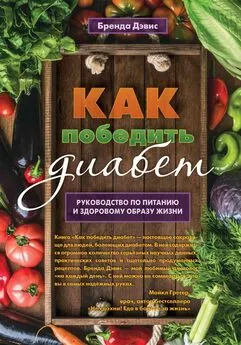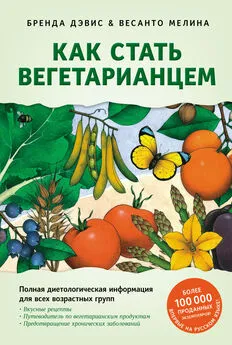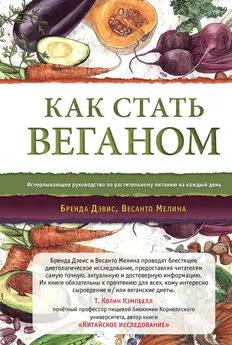Бренда Дэвис - Как победить диабет. Руководство по питанию и образу жизни
- Название:Как победить диабет. Руководство по питанию и образу жизни
- Автор:
- Жанр:
- Издательство:Ганга
- Год:2021
- Город:Москва
- ISBN:978-5-907243-84-2
- Рейтинг:
- Избранное:Добавить в избранное
-
Отзывы:
-
Ваша оценка:
Бренда Дэвис - Как победить диабет. Руководство по питанию и образу жизни краткое содержание
Как победить диабет. Руководство по питанию и образу жизни - читать онлайн бесплатно ознакомительный отрывок
Интервал:
Закладка:
16. Aydin Ö, Nieuwdorp M, Gerdes V. The Gut Microbiome as a Target for the Treatment of Type 2 diabetes. Genetics . 2018; 18(8): 55.
17. Islam MA, Alam F, Solayman M, et al. Dietary phytochemicals: Natural swords combating inflammation and oxidation-mediated degenerative diseases. Oxid Med Cell Longev . 2016; 2016: 5137431.
18. Aryaeian N, Sedehi SK, Arablou T. Polyphenols and their effects on diabetes management: A review. Med J Islam Repub Iran. 2017; 31: 134.
19. Silveira AC, Dias JP, Santos VM, et al. The action of polyphenols in Diabetes Mellitus and Alzheimer’s disease: a common agent for overlapping pathologies. Curr Neuropharmacol . 2018; 16.
20. Singh H, Venkatesan V. Treatment of ‘diabesity’: Beyond pharmacotherapy. Curr Drug Targets . 2018; 19(14): 1672–1682.
21. Carrera-Quintanar L, López Roa RI, Quintero-Fabián S, et al. Phytochemicals that influence gut microbiota as prophylactics and for the treatment of obesity and inflammatory diseases. Mediators Inflamm . 2018; 2018: 9734845.
22. Ahangarpour A, Sayahi M, Sayahi M. The antidiabetic and antioxidant properties of some phenolic phytochemicals: A review study. Diabetes Metab Syndr Clin Res Rev . 2019; 13(1): 854–857.
23. Silva B, Oliveira P, Casal S, et al. Promising potential of dietary (poly)phenolic compounds in the prevention and treatment of diabetes mellitus. Curr Med Chem . 2017; 24(4): 334–354.
24. Leiherer A, Mündlein A, Drexel H. Phytochemicals and their impact on adipose tissue inflammation and diabetes. Vascul Pharmacol . 2013; 58(1–2): 3–20.
25. Zhang D-W, Fu M, Gao S-H, Liu J-L. Curcumin and diabetes: A systematic review. Evidence-Based Complement Altern Med . 2013; 2013: 16.
26. Sanati S, Razavi BM, Hosseinzadeh H. A review of the effects of Capsicum annuum L. and its constituent, capsaicin, in metabolic syndrome. Iran J Basic Med Sci . 2018; 21(5): 439–448.
27. Zhu J, Chen H, Song Z, et al. Effects of ginger (Zingiber officinale Roscoe) on type 2 diabetes mellitus and components of the metabolic syndrome: A systematic review and meta-analysis of randomized controlled trials. Evid Based Complement Alternat Med . 2018; 2018: 5692962.
28. Fernando WMADB, Somaratne G, Goozee KG, et al. Diabetes and Alzheimer’s disease: Can tea phytochemicals play a role in prevention? J Alzheimer’s Dis . 2017; 59(2): 481–501.
29. Fu Q-Y, Li Q-S, Lin X-M, et al. Antidiabetic effects of tea. Molecules . 2017; 22(5): 849.
30. Szkudelski T, Szkudelska K. Resveratrol and diabetes: from animal to human studies. Biochim Biophys Acta – Mol Basis Dis . 2015; 1852(6): 1145–1154.
31. Öztürk E, Arslan AKK, Yerer MB, Bishayee A. Resveratrol and diabetes: A critical review of clinical studies. Biomed Pharmacother . 2017; 95: 230–234.
32. Behloul N, Wu G. Genistein: A promising therapeutic agent for obesity and diabetes treatment. Eur J Pharmacol . 2013; 698(1–3): 31–38.
33. Chen S, Jiang H, Wu X, Fang J. Therapeutic effects of quercetin on inflammation, obesity, and type 2 diabetes. Mediators Inflamm . 2016; 2016: 9340637.
34. Link LB, Potter JD. Raw versus cooked vegetables and cancer risk. Cancer Epidemiol Biomarkers Prev . 2004; 13(9): 1422–1435.
35. Roohbakhsh A, Karimi G, Iranshahi M. Carotenoids in the treatment of diabetes mellitus and its complications: A mechanistic review. Biomed Pharmacother . 2017; 91: 31–42.
36. Manna P, Jain SK. Obesity, oxidative stress, adipose tissue dysfunction, and the associated health risks: Causes and therapeutic strategies. Metab Syndr Relat Disord. 2015; 13(10): 423–444.
37. Yoo JY, Kim SS. Probiotics and prebiotics: present status and future perspectives on metabolic disorders. Nutrients. 2016; 8(3): 173.
38. Barengolts E. Gut microbiota, prebiotics, probiotics, and synbiotics in management of obesity and prediabetes: Review of randomized controlled trials. Endocr Pract . 2016; 22(10): 1224–1234.
39. Sáez-Lara MJ, Robles-Sanchez C, Ruiz-Ojeda FJ, et al. Effects of probiotics and synbiotics on obesity, insulin resistance syndrome, type 2 diabetes and non-alcoholic fatty liver disease: A review of human clinical trials. Int J Mol Sci . 2016; 17(6).
40. Baker EJ, Miles EA, Burdge GC, et al. Metabolism and functional effects of plant-derived omega-3 fatty acids in humans. Prog Lipid Res . 2016; 64: 30–56.
41. Molfino A, Amabile MI, Monti M, Muscaritoli M. Omega-3 Polyunsaturated fatty acids in critical illness: Anti-inflammatory, proresolving, or both? Oxid Med Cell Longev. 2017; 2017: 5987082.
42. Bhaswant M, Poudyal H, Brown L. Mechanisms of enhanced insulin secretion and sensitivity with n-3 unsaturated fatty acids. J Nutr Biochem . 2015; 26(6): 571–584.
43. Trautwein EA, Koppenol WP, De Jong A, et al. Plant sterols lower LDL-cholesterol and triglycerides in dyslipidemic individuals with or at risk of developing type 2 diabetes: A randomized, double-blind, placebo-controlled study. Nutr Diabetes . 2018; 8: 30.
44. Vilahur G, Ben-Aicha S, Diaz E, et al. Phytosterols and inflammation. Curr Med Chem . 2018; June 22 (e-pub ahead of print).
45. Derdemezis CS, Filippatos TD, Mikhailidis DP, Elisaf MS. Review article: effects of plant sterols and stanols beyond low-density lipoprotein cholesterol lowering. J Cardiovasc Pharmacol Ther . 2010; 15(2): 120–134.
46. Cooper AJM, Sharp SJ, Luben RN, et al. The association between a biomarker score for fruit and vegetable intake and incident type 2 diabetes: the EPIC-Norfolk study. Eur J Clin Nutr . 2015; 69(4): 449–454.
47. Liang J, Zhang Y, Xue A, et al. Association between fruit, vegetable, seafood, and dairy intake and a reduction in the prevalence of type 2 diabetes in Qingdao, China. Asia Pac J Clin Nutr . 2017; 26(2): 255–261.
48. Li M, Fan Y, Zhang X, et al. Fruit and vegetable intake and risk of type 2 diabetes mellitus: meta-analysis of prospective cohort studies. BMJ Open . 2014; 4(11): e005497.
49. Schwingshackl L, Hoffmann G, Lampousi A-M, et al. Food groups and risk of type 2 diabetes mellitus: a systematic review and meta-analysis of prospective studies. Eur J Epidemiol . 2017; 32(5): 363–375.
50. Clark JL, Taylor CG, Zahradka P. Rebelling against the (insulin) resistance: A review of the proposed insulin-sensitizing actions of soybeans, chickpeas, and their bioactive compounds. Nutrients . 2018; 10(4).
51. Agrawal S, Ebrahim S. Association between legume intake and self-reported diabetes among adult men and women in India. BMC Public Health . 2013; 13(1): 1.
52. Villegas R, Gao Y-T, Yang G, et al. Legume and soy food intake and the incidence of type 2 diabetes in the Shanghai Women’s Health Study. Am J Clin Nutr . 2008; 87(1): 162–167.
53. Tian S, Xu Q, Jiang R, Het al. Dietary protein consumption and the risk of type 2 diabetes: A systematic review and meta-analysis of cohort studies. Nutrients . 2017; 9(9).
54. Aune D, Norat T, Romundstad P, Vatten LJ. Whole grain and refined grain consumption and the risk of type 2 diabetes: A systematic review and dose-response meta-analysis of cohort studies. Eur J Epidemiol . 2013; 28(11): 845–858.
55. Ye EQ, Chacko SA, Chou EL, et al. Greater whole-grain intake is associated with lower risk of type 2 diabetes, cardiovascular disease, and weight gain. J Nutr . 2012; 142(7): 1304–1313.
56. Kyrø C, Tjønneland A, Overvad K, et al. Higher whole-grain intake is associated with lower risk of type 2 diabetes among middle-aged men and women: The Danish diet, cancer, and health cohort. J Nutr . 2018; 148(9): 1434–1444.
57. Asghari G, Ghorbani Z, Mirmiran P, Azizi F. Nut consumption is associated with lower incidence of type 2 diabetes: The Tehran Lipid and Glucose Study. Diabetes Metab . 2017; 43(1): 18–24.
58. Luo C, Zhang Y, Ding Y, et al. Nut consumption and risk of type 2 diabetes, cardiovascular disease, and all-cause mortality: A systematic review and meta-analysis. Am J Clin Nutr . 2014; 100(1): 256–269.
59. Vuksan V, Choleva L, Jovanovski E, et al. Comparison of flax (Linum usitatissimum) and Salbachia (Salvia hispanica L.) seeds on postprandial glycemia and satiety in healthy individuals: a randomized, controlled, crossover study. Eur J Clin Nutr . 2017; 71(2): 234–238.
60. Sylvia H. Ley, Osama Hamdy, V. Mohan FBH. Prevention and management of type 2 diabetes: dietary components and nutritional strategies. Lancet . 2014; 383(9933): 1999–2007.
61. Dam RM Van, Seidell JC. Carbohydrate intake and obesity. Eur J Clin Nutr. 2007; 61. Suppl 1: S75–99.
62. Buyken AE, Flood V, Empson M, et al. Carbohydrate nutrition and inflammatory disease mortality in older adults. Am J Clin Nutr . 2010; 3: 634–643.
63. Myles IA. Fast Food Fever: Reviewing the impacts of the western diet on immunity. Nutrition Journal . 2014: 13; 61.
64. DiNicolantonio JJ, Mehta V, Onkaramurthy N, O’Keefe JH. Fructose-induced inflammation and increased cortisol: A new mechanism for how sugar induces visceral adiposity. Prog Cardiovasc Dis . 2018; 61(1): 3–9.
65. Stanhope KL. Sugar consumption, metabolic disease and obesity: The state of the controversy HHS Public Access. Crit Rev Clin Lab Sci . 2016; 53(1): 52–67.
66. Bhardwaj B, O’keefe EL, O’keefe JH. Death by Carbs: Added sugars and refined carbohydrates cause diabetes and cardiovascular disease in Asian Indians. Mo Med . 2016; 113(5): 395–400.
67. Asgari-Taee F, Zerafati-Shoae N, Dehghani M, Sadeghi M, Baradaran HR, Jazayeri S. Association of sugar sweetened beverages consumption with non-alcoholic fatty liver disease: A systematic review and meta-analysis. Eur J Nutr . 2018. (e-pub ahead of print)
68. Liu B, Sun Y, Snetselaar LG, et al. Association between plasma trans-fatty acid concentrations and diabetes in a nationally representative sample of US adults. J Diabetes . 2018; 10(8): 653–664.
69. Dorfman SE, Laurent D, Gounarides JS, et al. Metabolic implications of dietary trans-fatty acids. Obesity . 2009; 17(6): 1200–1207.
70. Tsutsui W, Fujioka Y. Is the association between dietary trans-fatty acids and insulin resistance remarkable in Japan? J Atheroscler Thromb . 2017; 24: 1199–1201.
71. Liu B, Sun Y, Snetselaar LG, et al. Association between plasma trans-fatty acid concentrations and diabetes in a nationally representative sample of US adults. J Diabetes . 2018; 10(8): 653–664.
72. Zhang Q, Yang Y, Hu M, et al. Relationship between plasma trans-fatty acid isomer concentrations and self-reported cardiovascular disease risk in US adults. Int J Food Sci Nutr . 2018; 69(8): 976–984.
73. U.S. Department of Health and Human Services and U.S. Department of Agriculture. 2015–2020 Dietary Guidelines for Americans . 8th Edition. December 2015. URL: http://health.gov/dietaryguidelines/ 2015/guidelines/. Accessed October 29, 2018.
74. Eckel RH, Jakicic JM, Miller NH, et al. 2013 AHA / ACC Guideline on Lifestyle Management to Reduce Cardiovascular Risk A Report of the American College of Cardiology / American Heart Association Task Force on Practice Guidelines. Circulation . 2013: 1–46.
75. Koska J, Ozias MK, Deer J, et al. A human model of dietary saturated fatty acid induced insulin resistance. Metabolism . 2016; 65(11): 1621–1628.
Читать дальшеИнтервал:
Закладка:




![Карин Дина - Справочник сыроеда [Краткое руководство по питанию свежей растительной пищей]](/books/1060242/karin-dina-spravochnik-syroeda-kratkoe-rukovodstvo.webp)





